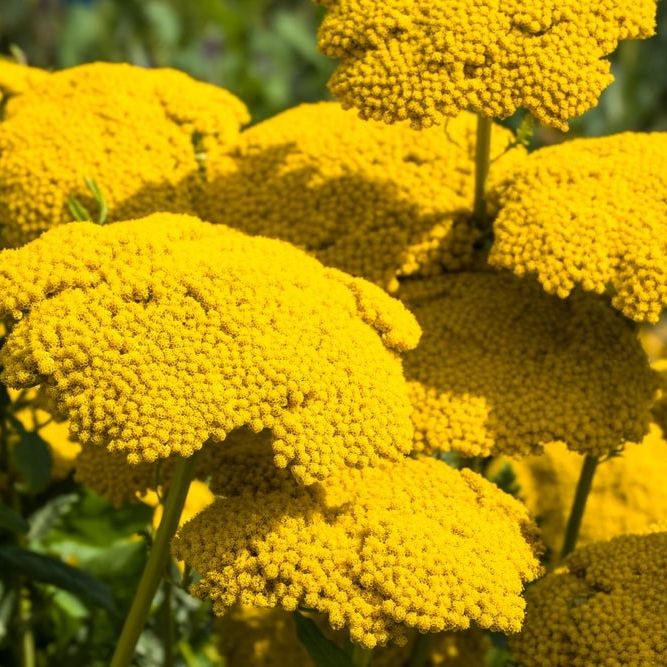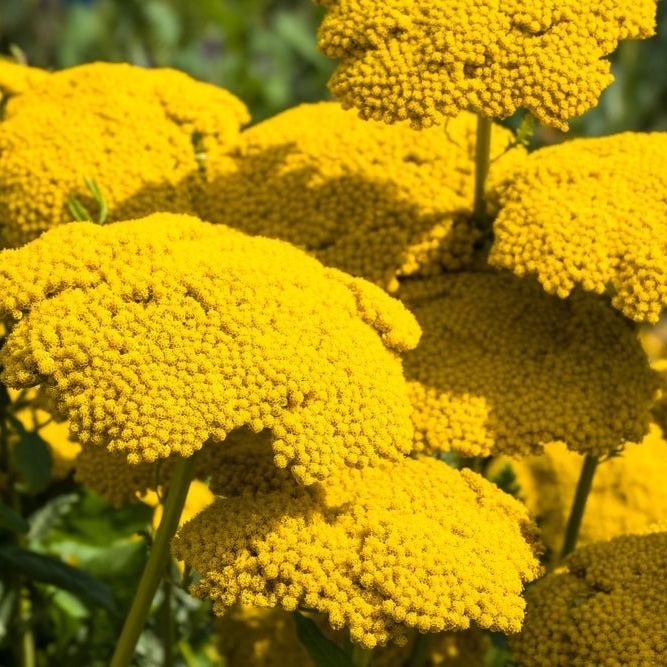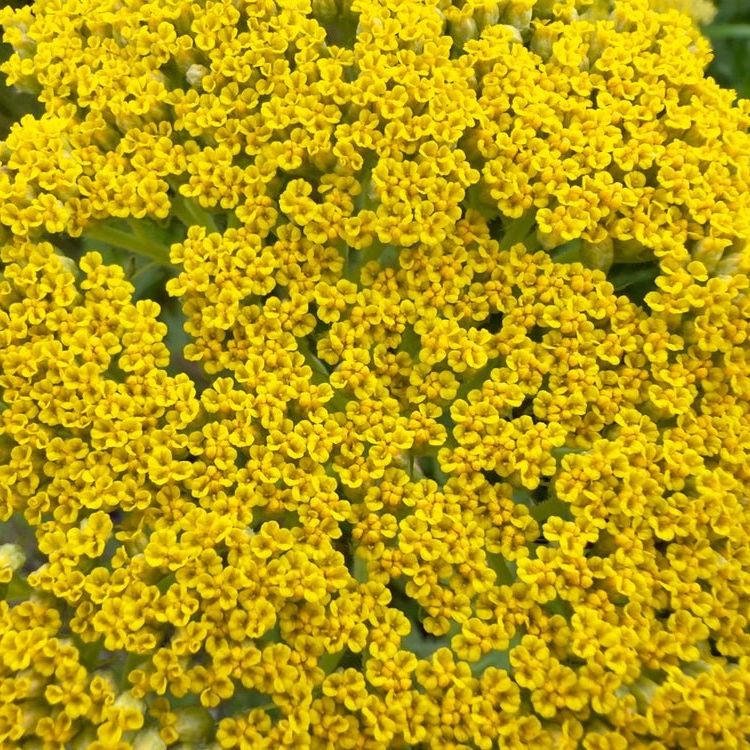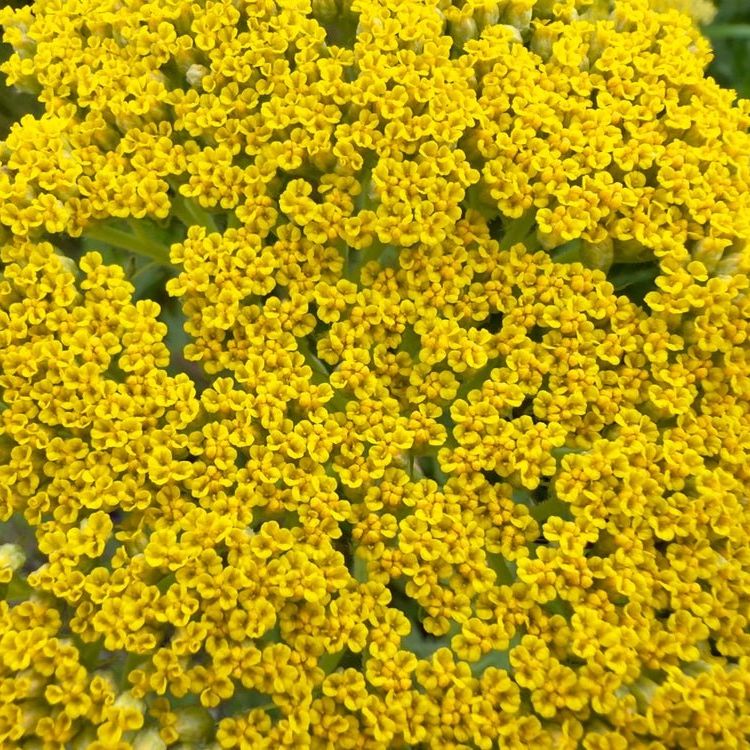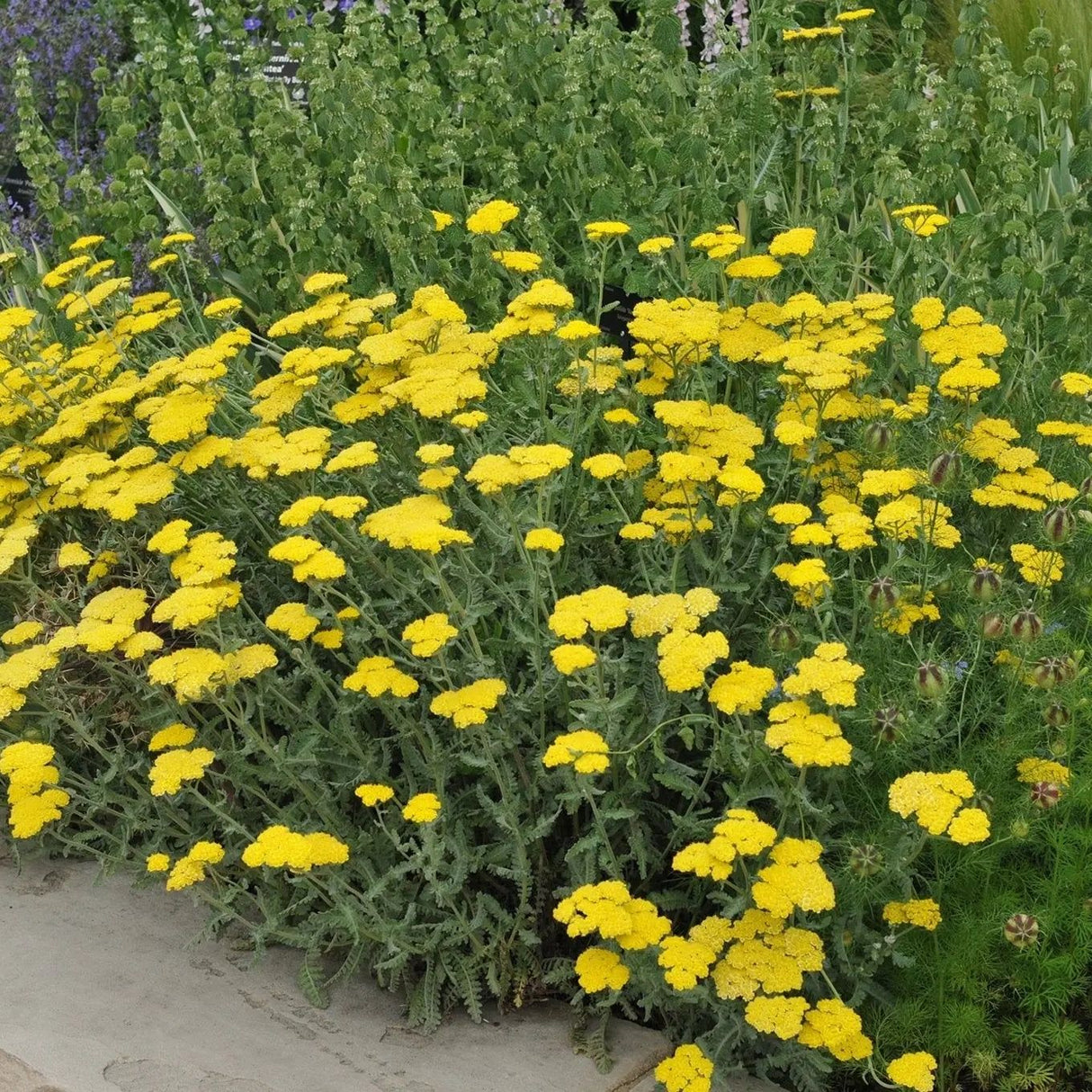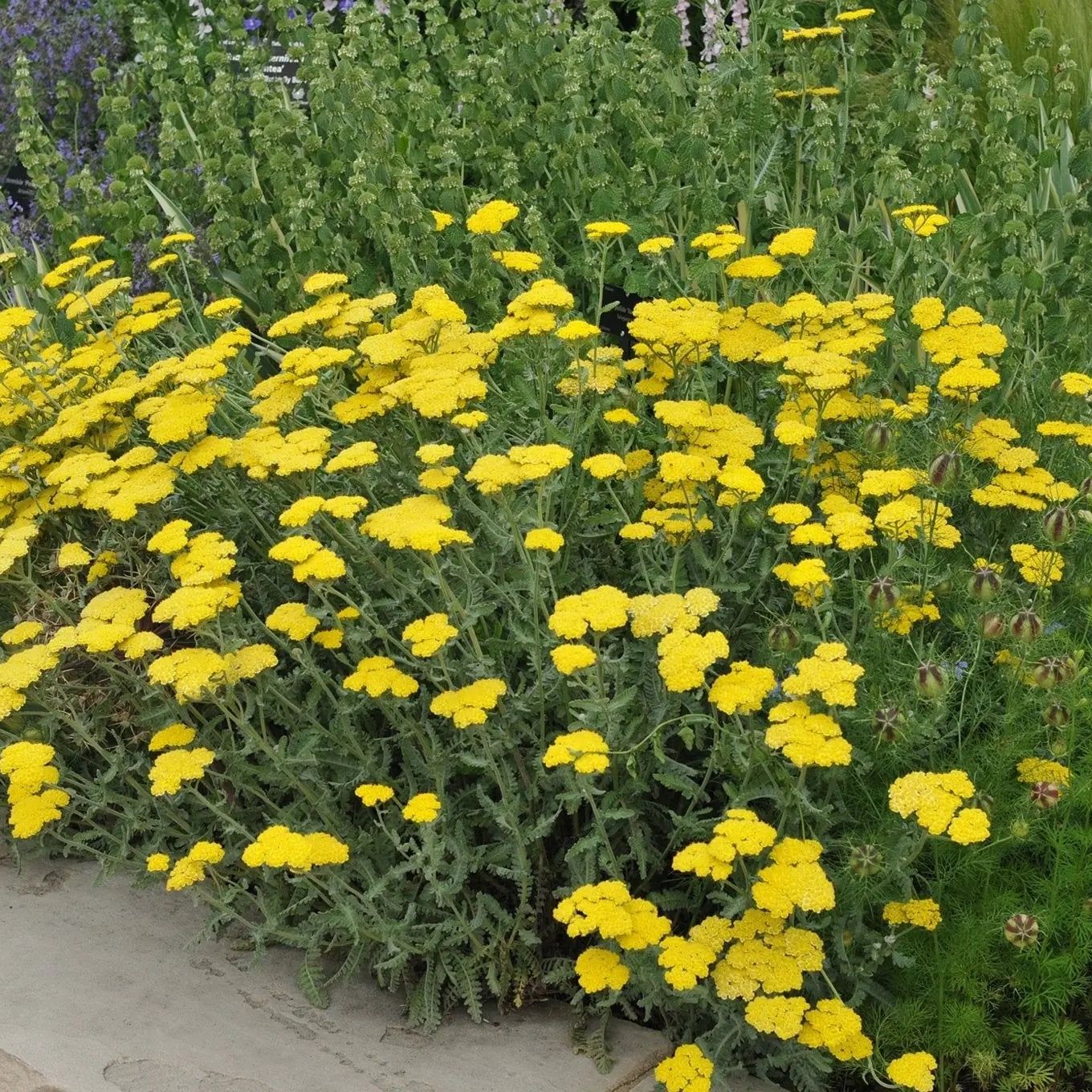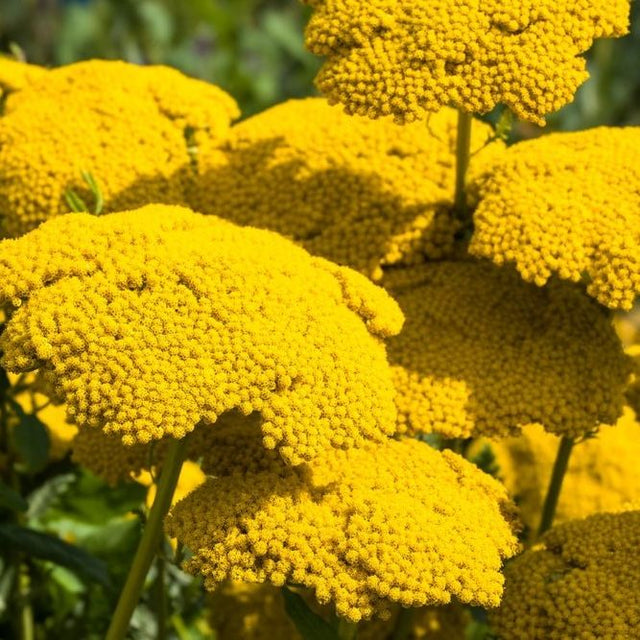Achillea Seeds - Golden Yarrow
Radiant and enduring, Golden Yarrow shines like sunlight captured in bloom—standing tall through summer heat and loved by bees and butterflies alike.
- Non-GMO Safe Seed Pledge
- Seed packets printed on forestry-certified paper (FSC, SFI, Rainforest Alliance)
- Curbside-recyclable mailers; SFI-certified kraft paper
- 1% for the Planet partner — supports environmental nonprofits
- Compact, energy-efficient facility with lean, low-waste operations
- Seeds: When properly stored, planted, and cared for, we guarantee reasonable germination and true-to-type growth for one year from purchase.
- Non-seed products: Free from defects in materials and workmanship for 30 days from shipment.
Excludes factors outside our control (extreme weather, pests, gardener error). If something’s off, contact us—we’ll make it right with a replacement, repair, or refund.
We do not sell seeds that are GMO or BE.
USDA “bioengineered (BE)” foods are those with detectable genetic material that was modified using in vitro recombinant DNA (rDNA) techniques, in ways not obtainable through conventional breeding or found in nature. The USDA’s National Bioengineered Food Disclosure Standard uses “bioengineered” as the nationwide labeling term.
- Detectable modified genetic material in the final food
- Created via in vitro rDNA techniques (e.g., gene transfer)
- Modifications not achievable through conventional breeding or nature
Description
Radiant and sun-loving, Golden Yarrow (Achillea filipendulina) glows with dense, flat clusters of golden-yellow blooms held high above sturdy, gray-green foliage. Its fernlike leaves form a strong, aromatic base, while the upright stems—often reaching 24–36 inches tall—bear flower heads that seem to capture and hold the midsummer sun.
Native to the Caucasus and parts of western Asia, this resilient perennial flourishes in full sun and well-drained soil, thriving even in poor or dry ground. Blooming from early summer through late fall, it is exceptionally drought-tolerant and beloved by pollinators, attracting bees, butterflies, and beneficial insects.
Perfect for borders, meadow plantings, or cutting gardens, Golden Yarrow offers both structure and brilliance. Its blooms dry beautifully, retaining their golden hue long after harvest. A symbol of vitality and clarity, it brings enduring brightness to the landscape—an ever-burning flame of summer gold.
Your payment is processed securely via trusted gateways. We do not store credit card details and we do not have access to your card information.
Couldn't load pickup availability
Soil Preparation: Ensure the soil is well-drained. Golden Yarrow prefers sandy or rocky soils but is adaptable to various soil types, including poor soils.
Sowing Seeds:
Direct Sowing: Sow the seeds directly outdoors in early spring or late fall. Scatter the seeds on the soil surface and lightly press them in without covering them too deeply, as they need light to germinate.
Indoor Starting: For an earlier start, sow seeds indoors 6-8 weeks before the last frost date. Use seed-starting trays filled with a seed-starting mix. Press the seeds lightly into the surface and keep the soil moist until germination.
Germination: Seeds typically germinate within 14-21 days. Maintain a consistent moisture level in the soil during this period.
Transplanting: If starting indoors, transplant seedlings outdoors after the danger of frost has passed. Space the seedlings 12-18 inches apart to allow for adequate air circulation and growth.
Care Instructions:
Watering: Once established, Golden Yarrow is drought-tolerant and requires minimal watering. Water sparingly, allowing the soil to dry out between waterings. Overwatering can lead to root rot and other fungal diseases.
Fertilizing: Golden Yarrow generally does not require fertilization, especially if planted in nutrient-poor soil. Over-fertilization can cause the plants to become leggy and weak.
Mulching: Apply a thin layer of mulch around the base of the plants to help retain moisture and suppress weeds. Avoid mulching too close to the stems to prevent rot.
Pruning and Deadheading: To encourage continuous blooming, deadhead spent flowers regularly. This will also prevent self-seeding. In late fall, cut back the stems to about 1-2 inches above the ground to tidy up the plant and prepare it for winter.
Pests and Diseases: Golden Yarrow is relatively pest and disease-free. However, it can occasionally be affected by aphids or powdery mildew. If necessary, treat with insecticidal soap or a fungicide.
Dividing Plants: Every 3-4 years, divide the plants in early spring or fall to rejuvenate them and prevent overcrowding. Dig up the clumps, separate them into smaller sections, and replant them in a suitable location.
Special Considerations:
Deer and Rabbit Resistance: Golden Yarrow is generally deer and rabbit resistant, making it a good choice for gardens in areas with these pests.
Pollinator Friendly: The flowers attract beneficial pollinators, including butterflies and bees, contributing to the health and biodiversity of your garden.
1. Choosing the Right Location
Light Requirements:
Yarrow flourishes in full sun, requiring at least 6–8 hours of direct sunlight daily for compact growth and abundant blooms. In areas with extremely hot summers, light afternoon shade can help prevent leaf scorch and extend the flowering period.
Soil Requirements:
Prefers well-drained, loamy or sandy loam soil with moderate fertility. Overly rich soil produces floppy growth and fewer flowers. The ideal soil pH range is 6.0–7.5.
Soil Preparation Tip:
Before planting, loosen the top 6–8 inches of soil and blend in a small amount of compost to improve structure without over-fertilizing. Yarrow performs best in lean soil—too much organic matter encourages excessive vegetative growth.
2. Watering and Moisture Management
Once established, yarrow is remarkably drought-tolerant. Water only as needed to keep the top 1–2 inches of soil from drying completely during prolonged droughts. Deep, infrequent watering strengthens the roots and enhances drought resistance.
Tip: Overwatering is a common mistake—yarrow prefers “tough love.” Allow the soil to dry between waterings to prevent root rot.
3. Fertilizing
Yarrow requires minimal feeding. Excessive nitrogen weakens stems and encourages floppy growth.
At planting, amend with compost if the soil is poor.
For established plants, top-dress lightly with compost in early spring.
Avoid liquid fertilizers or high-nitrogen blends entirely.
Tip: In dry or sandy soils, an annual spring compost dressing replenishes nutrients naturally without promoting lush, weak growth.
4. Weeding and Mulching
Weed young plantings regularly until plants are fully established. Mature yarrow forms dense mats of foliage that naturally suppress weeds.
Apply a thin layer of mulch (1–2 inches) around the base to retain moisture and regulate temperature, but keep mulch away from the crown to prevent rot.
Tip: Gravel mulch or coarse compost works best—avoid heavy bark mulches that trap moisture around the stems.
5. Temperature and Climate Conditions
Yarrow thrives in a wide range of climates, from cool northern summers to hot, dry southern zones. Optimal growing temperatures are 65–85°F (18–29°C). It tolerates both heat and cold well once mature, overwintering successfully in USDA Zones 3–9.
Tip: In humid climates, provide extra spacing and airflow to reduce fungal pressure during long wet spells.
6. Pruning and Deadheading
Regular pruning encourages continuous bloom and compact growth.
After the first flush of flowers, shear plants back by one-third to stimulate reblooming.
In late autumn or early spring, cut old stems to ground level to refresh new growth.
Tip: Removing faded blooms not only prolongs flowering but prevents unwanted self-seeding, helping maintain clean garden borders.
7. Dividing Mature Clumps
Divide yarrow every 3–4 years to rejuvenate plants and prevent overcrowding.
Dig up the entire clump in spring or fall.
Slice into smaller sections, each with roots and foliage.
Replant divisions immediately at the same depth as before.
Tip: Dividing in early spring encourages robust summer flowering, while fall division allows plants to establish before winter dormancy.
8. Pest and Disease Prevention
Yarrow is naturally resistant to most pests and diseases, but a few issues can arise in poor conditions:
Aphids & Spittlebugs: Rinse off with a strong water jet or apply neem oil.
Powdery Mildew: Improve airflow, avoid overhead watering, and apply sulfur or compost tea sprays preventively.
Root Rot: Avoid soggy soils; ensure excellent drainage.
Tip: Interplant yarrow with herbs like sage, dill, or fennel to attract beneficial insects and reduce pest pressure naturally.
9. Maintaining Flower Quality
For continuous color through summer and early autumn:
Deadhead promptly to encourage new stems.
Feed lightly with compost midseason.
Water sparingly but deeply during long dry spells.
Tip: In cut flower production, harvest early in the day and recut stems under water for maximum vase life.
10. Supporting Pollinators & Beneficial Insects
Yarrow’s flat, nectar-rich umbels attract a wide array of pollinators and predatory insects.
Bees rely on yarrow as a consistent midsummer nectar source.
Lady beetles, hoverflies, and lacewings use yarrow as habitat, feeding on pests such as aphids and mites.
Tip: Scatter yarrows throughout vegetable beds to naturally improve pest management and increase pollination rates.
11. Seasonal Maintenance Calendar
Spring: Divide mature clumps, top-dress with compost, and prune winter growth.
Summer: Water sparingly, deadhead frequently, and shear after bloom for reblooming.
Autumn: Cut back spent stems, collect seed heads, and mulch lightly before frost.
Winter: Leave a few dried stalks standing for wildlife shelter if desired.
Tip: Leaving winter seed heads provides food and habitat for birds and beneficial insects—cut them back in early spring.
12. Container and Small-Space Growing
Yarrow grows beautifully in large pots or raised beds.
Container Depth: Minimum 10–12 inches.
Soil Mix: Fast-draining, sandy potting soil with added compost.
Watering: Allow the top inch to dry between waterings; avoid soggy conditions.
Fertilizing: Feed lightly with compost once per season.
Tip: Container-grown yarrow benefits from full sun and periodic trimming—perfect for patios, balconies, and pollinator-friendly storefronts.
13. Ecological Interplanting & Soil Health
Yarrow is a keystone perennial in regenerative and organic gardening systems.
Soil Aeration: Deep roots break up compacted soils and draw up minerals.
Biodiversity Boost: Its blooms attract dozens of beneficial insect species.
Erosion Control: Ideal for slopes and poor soils prone to runoff.
Companion Role: Plant near herbs and vegetables to attract pollinators and stabilize soil microclimates.
Tip: Incorporate yarrow into ecological border plantings—it improves soil structure, reduces maintenance needs, and enhances the vitality of the entire garden ecosystem.
Conclusion:
Yarrow’s ease of growth, drought tolerance, and ecological value make it one of the most dependable perennials for sustainable gardens. Once established, it rewards the grower with vivid blooms, fragrant foliage, and enduring resilience. Whether in borders, wild meadows, or containers, yarrow asks for little—and gives back in abundance.
Harvesting
For Fresh Bouquets:
Harvest stems when the golden flower clusters are fully open and richly colored, but before the tiny central florets begin to darken. Morning harvest ensures strong stems and bright color. Place immediately into cool water after cutting, and strip foliage that would sit below the water line.
For Dried Arrangements:
Cut stems when blooms reach their deepest gold. Bundle 6–8 stems and hang upside down in a shaded, dry, airy space for 10–14 days. Drying slowly out of sunlight preserves the golden hue and prevents brittleness.
Tip: Harvest when the flowers are almost—but not completely—mature to preserve the warm color and fine texture through drying.
Aesthetic & Functional Uses
Cut Flowers:
Golden Yarrow brings brightness and structure to summer bouquets, market bunches, and large floral displays. Its vibrant color complements cool-toned blooms like lavender or blue sage and adds warmth to neutral palettes.
Dried Crafts:
An excellent choice for everlasting wreaths, arrangements, and rustic decor, as it holds its color and form for many months.
Landscape Design:
Perfect for borders, dry gardens, and pollinator meadows, Golden Yarrow’s upright form and glowing hue create a sunlit focal point that persists long into the season.
Tip: Plant alongside ornamental grasses or silvery foliage (like Artemisia or lamb’s ear) for visual balance and texture contrast.
Handling & Storage
Fresh Stems:
Keep in deep, cool water and change every 2–3 days. Recut stems before placing in vases to extend longevity.
Dried Blooms:
Store in paper-lined boxes or cardboard crates in a cool, dark location. Avoid exposure to direct sunlight or humidity, which can dull the color.
Tip: For display, bundle stems by bloom size—smaller heads for delicate arrangements, larger heads for statement pieces.
Growth & Maintenance
Sunlight: Requires full sun (6–8 hours daily) for strongest color and structure.
Watering: Water sparingly after establishment; Golden Yarrow thrives in dry conditions.
Soil: Prefers loamy or sandy loam soils with excellent drainage.
Pruning: Cut back spent blooms to promote a second flowering flush.
Division: Divide every 3–4 years to renew vigor and prevent overcrowding.
Tip: Overly rich soil leads to tall, floppy stems; lean, dry soil produces sturdier growth and truer color.
Seed Saving
Allow selected flower heads to remain on the plant until they dry and turn brown. Cut and hang upside down in paper bags for 7–10 days, then rub or shake out the small seeds.
Golden Yarrow rarely crosses with A. millefolium, making it reliable for seed saving. Label and store in airtight jars in a cool, dark place for up to 3 years.
Tip: Collect seed only from your best, most upright plants to maintain strong structure and vivid color in the next generation.
Ecological & Soil Benefits
Pollinator Support: Its nectar-rich flowers attract bees, butterflies, and hoverflies.
Drought Resilience: Deep roots help the plant thrive in dry soils and reduce erosion.
Soil Improvement: Adds organic matter and stabilizes slopes with its fibrous root network.
Habitat Value: Provides late-season nectar when other blooms have faded.
Tip: Use Golden Yarrow in ecological borders or xeriscapes—it sustains pollinators while brightening even the driest garden corners.
Presentation & Display Tips
Fresh Sales: Display upright in galvanized buckets or rustic pails to highlight golden hues against green foliage.
Dried Displays: Pair with white statice, dried lavender, or bleached grains for timeless natural arrangements.
Market Labeling: Emphasize “Long-Blooming,” “Pollinator Friendly,” and “Drought Tolerant” for eco-conscious buyers.
Tip: Golden Yarrow symbolizes vitality and endurance—market it as the “Sun of the Garden,” brightening landscapes, bouquets, and spirits alike.
Insects & Mites
Aphids (sticky residue, distorted tips, yellowing leaves)
Controls: Aphids are the most common insect on yarrow, particularly in spring and early summer when growth is soft and new. Inspect the undersides of leaves and developing flower buds weekly. For light infestations, blast plants with a firm stream of water to dislodge them. For heavier outbreaks, apply neem oil or insecticidal soap every 5–7 days until populations decline. Encourage lady beetles, lacewings, and hoverflies, which naturally prey on aphids. Avoid overfertilization, which encourages tender, pest-attracting growth.
Spittlebugs (frothy white “spit” on stems or leaf joints)
Controls: These insects rarely cause serious damage but can spoil appearance. Wash off spittle masses with a strong jet of water. Maintain airflow and avoid excessive nitrogen, which encourages lush growth favored by spittlebugs. Beneficial insects and spiders often control them naturally.
Thrips (silvered or streaked petals, tiny dark specks)
Controls: Thrips feed on developing flowers and can distort blooms. Use blue sticky traps to monitor populations. Spray with neem oil or insecticidal soap weekly at first signs. Keep plants well-watered during dry spells—stressed foliage attracts thrips more readily.
Leafhoppers (small wedge-shaped insects, stippled yellowing on leaves)
Controls: Leafhoppers may appear in warm, dry weather. Use row covers on young plants, remove nearby weeds, and spray with pyrethrin-based organic insecticides if needed. Neem oil or insecticidal soap also deter feeding. Promote predatory insects such as damsel bugs and spiders.
Spider Mites (fine webbing, bronzed or stippled leaves)
Controls: Mites flourish in hot, dusty, and drought-stressed conditions. Rinse foliage regularly, especially during heat waves, to remove dust and eggs. Increase humidity by misting or placing mulch around the base. Apply horticultural oil or neem oil as needed. Keeping plants well-watered and dust-free helps prevent infestations.
Diseases
Powdery Mildew (white or gray coating on leaves and stems)
Controls: Yarrow may develop powdery mildew in hot, dry weather with poor airflow. Thin crowded clumps, water early in the day, and avoid wetting foliage. Apply sulfur or potassium bicarbonate sprays at the first sign of infection. Regular compost tea foliar sprays can boost disease resistance.
Botrytis (Gray Mold) (fuzzy gray growth on dying stems or spent flowers)
Controls: Remove faded blooms promptly and avoid overhead watering. Increase air circulation, particularly in humid climates. A preventive neem oil or copper-based spray can help in prolonged wet weather.
Root Rot (wilting, yellowing, stunted plants, dark roots)
Controls: Caused by soggy, poorly drained soil. Yarrow requires excellent drainage and dislikes wet feet. Amend heavy soil with sand or compost, water only when the top inch of soil is dry, and plant in raised beds or slopes where possible. Avoid mulching too close to the crown.
Rust (orange-brown pustules on undersides of leaves)
Controls: Rust is uncommon but can occur in prolonged humidity. Remove infected leaves immediately and dispose of them away from the garden. Apply organic sulfur or neem-based fungicides preventively. Maintain plant spacing to improve airflow.
Physiological & Environmental Issues
Flopping or Weak Stems
Cause: Overly fertile soil, insufficient sunlight, or excessive moisture.
Remedy: Grow in full sun, limit nitrogen-rich fertilizers, and divide overcrowded clumps every few years. Cut back after flowering to encourage dense regrowth.
Yellowing Leaves (Chlorosis)
Cause: Poor drainage or nutrient imbalance.
Remedy: Improve soil aeration and apply compost or balanced organic fertilizer (5-5-5). Avoid overwatering.
Reduced Blooming
Cause: Excessive shade or aging clumps.
Remedy: Relocate plants to full sun and divide mature clumps every 3–4 years to rejuvenate vigor.
Powdery Foliage or Burnt Tips
Cause: Overapplication of fertilizers or concentrated foliar sprays.
Remedy: Rinse leaves with clean water and adjust future feeding. Yarrow thrives best in lean soils with minimal inputs.
Monitoring & Prevention — Quick Checklist
Inspect plants weekly for aphids, mites, or fungal symptoms.
Avoid overwatering—yarrow prefers dry, well-drained conditions.
Divide clumps every 3–4 years to maintain airflow and vigor.
Deadhead regularly to reduce fungal risk and promote continuous blooms.
Encourage beneficial insects by interplanting with dill, fennel, or calendula.
Mulch lightly to retain moisture and suppress weeds, but keep mulch off the crown.
Practice crop rotation and garden hygiene—remove debris and spent flowers after each season.
Q: What is Golden Yarrow?
Golden Yarrow (Achillea filipendulina) is a long-lived perennial distinguished by its tall, sturdy stems and brilliant clusters of golden-yellow blooms. Native to the Caucasus and parts of western Asia, this species is often called “Fernleaf Yarrow” for its finely divided, silvery foliage. It’s a beloved garden perennial for its drought tolerance, upright form, and long-lasting color that brightens borders and cutting gardens alike.
Q: How long does Golden Yarrow take to germinate?
Seeds germinate in 14–21 Days when kept at 65–75°F (18–24°C). Press the seeds lightly into the soil surface—they require light to germinate—and keep evenly moist until sprouts appear.
Q: What kind of soil does Golden Yarrow prefer?
Golden Yarrow thrives in loamy or sandy loam soils that are well-drained. It performs best in moderately fertile to lean soils and tolerates dry, rocky conditions once established. Soil pH between 6.0 and 7.5 is ideal.
Q: How much sunlight does Golden Yarrow need?
Provide full sun—at least 6–8 hours daily. Strong sunlight promotes sturdy stems and vibrant golden color, while too much shade can lead to weak, floppy growth.
Q: Is Golden Yarrow an annual or perennial?
Golden Yarrow is a perennial, hardy in USDA Zones 3–9. It returns each year from its deep, fibrous roots and becomes more robust over time.
Q: How tall does Golden Yarrow grow?
This species typically grows 24–36 inches tall and about 18–24 inches wide, forming upright clumps with strong, unbending stems that make it ideal for cutting gardens and meadow plantings.
Q: How often should I water Golden Yarrow?
Water moderately during establishment, then reduce frequency once the plant matures. Golden Yarrow is highly drought-tolerant and prefers dry to medium soil moisture. Avoid soggy or compacted soil, which can lead to root rot.
Q: Can I grow Golden Yarrow in containers?
Yes. Golden Yarrow adapts well to large, well-drained containers. Choose pots at least 12 inches deep, and use a gritty or sandy mix to ensure drainage. Container-grown plants may need extra watering during hot, dry spells.
Q: When does Golden Yarrow bloom?
Golden Yarrow blooms from early summer through late fall, offering one of the longest flowering periods among yarrows. Removing spent flower heads encourages continued blooming and maintains a tidy appearance.
Q: Does Golden Yarrow attract pollinators or beneficial insects?
Yes. Its bright umbels attract bees, butterflies, and other beneficial insects, serving as an important nectar source in pollinator gardens.
Q: How can I propagate Golden Yarrow?
Propagate by seed, cuttings, or division. Mature clumps can be divided every 3–4 years in spring or fall to rejuvenate plants and prevent overcrowding.
Q: Are there any pests or diseases to watch for?
Golden Yarrow is notably hardy and pest-resistant. In overly humid or poorly drained environments, powdery mildew or root rot may occur. Good airflow and dry soil conditions minimize risks.
Q: Is Golden Yarrow deer or rabbit resistant?
Yes. The fragrant foliage naturally deters deer and rabbits, making it an excellent low-maintenance choice for wildlife gardens.
Q: Can I use Golden Yarrow as a cut or dried flower?
Absolutely. Golden Yarrow is one of the best yarrows for cut and dried arrangements. The blooms hold their shape and bright color for months when air-dried in a shaded, ventilated area.
Q: How long does Golden Yarrow live?
With minimal care and periodic division, Golden Yarrow can live and bloom for many years, spreading slowly to form lasting colonies of golden radiance.
From Seed Indoors (Spring)
From Plant (Spring)
Fall Planting
Expected First Bloom
Is this a good fit for your garden?
Origins and Etymology
Golden Yarrow (Achillea filipendulina) hails from the mountainous regions of the Caucasus, Iran, and Central Asia, where its sun-bright flowers rise above silver-green foliage under the heat of dry summer slopes. Though distinct from the widespread Achillea millefolium, it belongs to the same ancient lineage—members of the genus Achillea, named for the Greek hero Achilles, famed for his use of herbs to heal his warriors.
The species name filipendulina comes from the Latin filum (thread) and pendulus (hanging), referencing the fine, threadlike rootlets that dangle from its fibrous crown. This species was introduced into European gardens in the 1800s, valued for its durability, strong stems, and radiant golden blooms that held their color when dried—a gift of summer sunlight preserved through winter.
Cultural Significance and Lore
Like its white-flowered cousin, Golden Yarrow carries a legacy of symbolism rooted in healing, valor, and renewal. To the ancients, yellow was the color of divine light and clarity, and this plant’s golden umbels came to embody vitality, balance, and the endurance of the spirit.
Across many cultures, yarrow marked boundaries and transitions—life and death, protection and passage. In parts of Asia and the Mediterranean, yellow yarrows were associated with the sun’s energy and used in midsummer observances to bless fields and ensure fertility. In more recent centuries, gardeners came to view it as a bridge between the wild and the ornamental, linking the rugged landscapes of its origin with the cultivated order of human design.
Historic Uses and Associations
Though Achillea filipendulina was not traditionally used in herbal medicine as widely as A. millefolium, its close kinship ensured it inherited much of the same reverence. Early herbalists noted its fragrance and resilience, admiring its longevity in the field and its ability to thrive in dry soils. In garden culture, it became known as “Fernleaf Yarrow,” prized both for its texture and its power to endure heat where other flowers faded.
Its introduction into Victorian gardens coincided with a renewed fascination for classical symbolism—plants that suggested courage, discipline, and light. Golden Yarrow quickly found its place as a living emblem of fortitude and optimism, valued as much for its steadfast bloom as for its unyielding nature.
Cultural Presence in Ritual and Memory
In folk traditions, yellow flowers have long represented the sun’s blessing—energy, protection, and the triumph of light over darkness. As such, Golden Yarrow was sometimes woven into harvest garlands and displayed in homes to invite abundance. Its color, rich and enduring, became synonymous with constancy and vitality.
The plant’s strength, combined with its luminous hue, made it a symbol of perseverance—an emblem of the life that persists through adversity and drought.
Modern Symbolism
Today, Golden Yarrow stands as a beacon of brightness and resilience. Its golden flower heads recall both the sun of its native hills and the enduring light of hope that transcends hardship. In gardens, it remains a favorite for its steadfast beauty and ecological grace—feeding pollinators, anchoring soil, and reminding those who tend it that true strength often blooms in the driest ground.
1. Selecting Plants for Seed Saving
Choose strong, healthy yarrow plants with upright growth, richly colored blooms, and no signs of disease or root rot. Favor plants with sturdy stems, symmetrical flower clusters, and aromatic foliage.
For Achillea millefolium types (Red, Summer Pastels, Summer Berries, Common White): select true-to-color plants that show stable flower shades and uniform form.
For Achillea filipendulina (Golden Yarrow): prioritize upright, full-flowered specimens with deep golden tones and strong drought tolerance.
Avoid saving seed from plants that flop, display irregular bloom color, or suffer fungal spotting. Mark your ideal plants early in the bloom season for easy identification later.
Tip: Save seeds from at least 10–15 plants to maintain healthy genetic diversity and local adaptation.
2. Flowering and Maturation
Yarrow blooms throughout summer, forming flat-topped clusters (corymbs) of tiny composite flowers. As the season advances, spent blooms dry and turn light brown or tan.
Each flower head produces dozens of small, flat, grayish seeds (achenes).
Seeds are mature when the heads are dry, crisp, and rattle slightly when shaken.
Timing: Generally, yarrow seed matures 90–120 days after planting or about 3–4 weeks after flowering ends.
Tip: Wait until the seed heads are completely dry before cutting—premature harvest reduces viability.
3. Pollination and Isolation
Yarrow is insect-pollinated, mainly by bees, flies, and butterflies. Cross-pollination occurs between nearby plants of the same species, particularly among A. millefolium types.
To maintain varietal purity:
Isolate by at least 500 feet from other Achillea varieties of the same species.
Alternatively, mesh-bag selected flower heads once they begin to open, removing the bag after pollination to allow drying naturally on the plant.
Tip: For color-specific cultivars (like Red, Summer Pastels, and Summer Berries), isolation or bagging is crucial to preserve consistent bloom hues.
4. Harvesting Seeds
Harvest in dry weather once seed heads are uniformly tan and brittle but before wind or birds disperse them.
Cut entire stems and place them head-down in paper bags.
Hang upside down in a dry, shaded, well-ventilated area for 7–10 days to finish curing.
Rub flower heads gently between your palms or over a fine mesh screen to release the seeds.
Tip: Handle dried heads carefully—overly dry seed can shatter easily during processing.
5. Cleaning Seeds (Natural & Organic Methods)
After threshing, separate seeds from chaff using one or more methods:
Winnowing: Pour the seed mixture slowly in front of a fan on low speed to blow away light debris.
Sieving: Use fine mesh screens to separate seeds from larger stems or flower pieces.
Natural rinse (optional): A brief dip in a mild chamomile tea solution can deter fungal spores—dry thoroughly afterward.
Tip: Always clean seed gently; yarrow seed is small and easily lost in heavy airflow.
6. Drying Seeds
Spread cleaned seeds in a thin, even layer on parchment paper, fine mesh, or breathable cloth trays.
Dry in a shaded, well-ventilated space at temperatures below 95°F (35°C) until seeds are firm and brittle.
Avoid direct sunlight or high heat, which can damage germination rates.
Tip: In humid regions, use a fan or a dehydrator set no higher than 85°F (29°C) to complete drying safely.
7. Storing Seeds
Once fully dry:
Store in airtight glass jars or tins with silica gel or dry rice as a desiccant.
Keep containers in a cool, dark, and dry place (ideally 35–45°F / 1–7°C).
Paper packets are fine for short-term use; airtight containers are best for long-term storage.
Properly stored, yarrow seed remains viable for 2–3 years.
Tip: Label all containers clearly with species, color, harvest year, and location to ensure traceability and purity.
8. Testing Seed Viability
Perform a germination test before each sowing season:
Place 10 seeds on a moistened paper towel.
Seal in a plastic bag and keep at 70–75°F (21–24°C) in bright, indirect light.
Check after 14–21 days.
Results:
8–10 seeds sprouted = Excellent viability.
6–7 = Acceptable; sow more densely.
Below 6 = Replace with new stock.
Tip: Yarrow seeds are slow to sprout—patience and steady moisture are key.
9. Preventing Cross-Pollination
To ensure color and form remain consistent year after year:
Grow only one yarrow color or species per seed-saving plot.
If space is limited, bag select flower heads as soon as buds open.
Avoid saving seed from hybrid cultivars (Summer Berries, Summer Pastels) if uniformity is desired, since offspring may revert to mixed colors.
Tip: For precise color strains, vegetative propagation (root division) is more reliable—but seed saving preserves diversity and adaptation.
10. Record Keeping and Documentation
Maintain notes for each seed line, including:
Parent plant color, height, and vigor.
Bloom start and end dates.
Isolation distance or bagging method used.
Harvest and drying conditions.
Germination test results.
Accurate records allow refinement of your line over successive generations, ensuring consistent quality and adaptation to local conditions.
11. Organic Tips for Success
Use rainwater or dechlorinated water for rinsing or testing seeds.
Compost the remaining plant material after seed harvest to return nutrients to the soil.
Rotate planting sites every 3–4 years to avoid soil fatigue and disease buildup.
Encourage pollinators like bees and hoverflies by interplanting dill, fennel, or calendula nearby.
Avoid synthetic fungicides or coatings—natural plant diversity builds stronger genetics and resilience.
Tip for Growers:
Saving yarrow seed is both practical and regenerative—each year’s seed becomes more attuned to your soil, your weather, and your care, embodying the living memory of your landscape in every tiny floret.
Culinary Uses
Yarrow is sometimes used as a culinary herb and aromatic garnish, adding a distinctive, resinous flavor similar to tarragon and sage. Its use should be moderate and informed, as the flavor is strong and slightly bitter.
Leaves:
Young leaves can be finely minced and incorporated sparingly into soups, stews, and herb butters, or used to flavor vinegars and oils. The tender spring foliage has the mildest taste and complements savory dishes.
Flowers:
The blossoms are occasionally added to teas, liqueurs, or homemade bitters for their subtle fragrance. Dried flower clusters make an attractive garnish or aromatic infusion base.
Teas & Infusions:
Both leaves and flowers may be steeped in hot water for a light, aromatic herbal tea, often blended with mint, lemon balm, or chamomile for balance.
Culinary Pairings:
Yarrow pairs well with other robust herbs such as rosemary, thyme, or sage, and its earthy notes enhance recipes featuring potatoes, mushrooms, or poultry.
Preservation:
Drying: Hang leaves and flowers upside down in shade until crisp, then store in airtight containers.
Storage: Keep in a cool, dry place away from sunlight to preserve aroma and color.
Tip: Always use in small quantities—yarrow’s intensity is best experienced as an accent flavor.
Nutritional and Botanical Qualities
Though not a staple food plant, yarrow contains aromatic oils, natural tannins, and plant-based compounds that contribute to its traditional value. Historically, these traits were appreciated for their invigorating and cleansing character, both in food and folk practices.
The plant’s feathery foliage and fine-textured flowers have long been associated with purity, resilience, and renewal, making yarrow a meaningful addition to gardens centered on wellness, heritage, and natural beauty.
Cultural and Historical Uses
Yarrow has held symbolic and practical importance for millennia, appearing in folklore, ceremony, and herbal traditions across Europe, Asia, and North America.
Heritage and Symbolism:
In European lore, yarrow symbolized endurance, courage, and protection. The genus name Achillea recalls the Greek hero Achilles, who, legend says, used the plant to tend battlefield wounds.
Indigenous peoples in North America regarded yarrow as a respected ceremonial and cleansing plant, valued for its aroma and connection to renewal.
In folklore, it was often placed in doorways or carried as a charm for blessing and protection.
These stories endure today as reflections of the deep relationship between people and plants—yarrow representing the link between earth, healing, and spiritual strength.
Cultural and Practical Benefits
Yarrow’s gifts extend beyond folklore—it is a cornerstone species in ecological and ornamental gardening.
Pollinator Support:
Its broad flower clusters attract bees, butterflies, hoverflies, and other beneficial insects, making it invaluable in pollinator habitats.
Drought Resistance:
Once established, yarrow thrives on minimal water, perfect for xeriscaping and regenerative landscaping.
Low Maintenance:
It prospers in poor, dry, or sandy soils, requiring little care once rooted. This adaptability makes it a favorite among sustainable gardeners.
Visual Appeal:
From soft pastels to bright golds and reds, yarrow adds long-lasting color and texture to borders, rock gardens, and wildflower meadows.
Everyday and Decorative Uses
Teas & Aromatics:
Dried yarrow may be used in herbal sachets, potpourri, and natural incense blends, prized for its clean, earthy fragrance.
Bouquets & Crafts:
The flowers dry beautifully, holding their shape and hue for everlasting arrangements and wreaths.
Companion Plant:
Yarrow is known to encourage beneficial insect activity in gardens and may help nearby plants by improving habitat diversity.
Tip: Interplant with herbs or vegetables—its fine texture and subtle fragrance enhance both beauty and ecological function.
Environmental and Garden Benefits
Yarrow plays a vital role in soil restoration and biodiversity:
Soil Enrichment: Its deep roots help draw up minerals and improve soil structure.
Erosion Control: Dense root systems stabilize slopes and prevent runoff.
Habitat Restoration: Excellent for meadows, pollinator corridors, and native rewilding projects.
Natural Resilience: Its tolerance of poor soils and low rainfall makes it ideal for sustainable gardens and naturalized landscapes.
Tip: After flowering, trim back to promote fresh foliage and a second bloom cycle, or allow the seed heads to stand as winter habitat for insects and birds.
Culinary & Cultural Legacy
Yarrow bridges the worlds of wild flora, folklore, and modern horticulture. Once a plant of ancient rituals and rural meadows, it now graces home gardens as both a symbol of endurance and a living support for pollinators.
From Golden Yarrow’s sunlit umbels to the soft hues of Summer Pastels, each variety carries forward an ancient lineage of usefulness and beauty.
Summary Tip:
Yarrow is a living emblem of balance between nature and culture—beautiful, enduring, and generous to the garden and the gardener alike. It invites us to cultivate not only plants but harmony, memory, and resilience in the land itself.
Shipped from U.S.A.
Our seeds are grown and sourced from the US. They're then packed and shipped from Colerain NC.
Triple tested
We regularly test the quality and germination rate of our seeds. We're so confident that our seeds are backed by a 1 year warranty!
Soil Readiness
for Yarrow (Achillea millefolium)Where to get a soil test
Best option: your state’s Cooperative Extension soil testing lab.
Summary
Recommended Amendments (per 100 sq ft)
How to Use
- Mix P & K sources into top 3–6″ a week or two before sowing/transplanting.
- If pH is low, apply lime 3–4 weeks pre-plant (or fall/winter).
- Yarrow is a light feeder—too much N causes floppy growth and fewer blooms. Use only a gentle starter and side-dress sparingly.
- Add 1–2″ finished compost yearly; avoid heavy manure composts.
Payment & Security
Payment methods
Your payment information is processed securely. We do not store credit card details nor have access to your credit card information.
Join Our Newsletter for Exclusive Savings!
Sign up for our newsletter to get a 30% discount code sent straight to your inbox. If it doesn’t appear right away, please check your inbox settings, and if you still need help, we’re here to assist!

